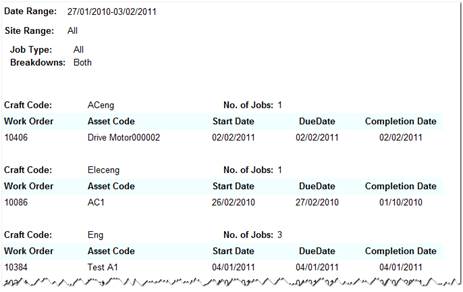Number of Jobs Analysis
Description
This report returns a total count of works orders generated within the selected date range which can be sequenced by a variety of predetermined sort order options.
The report cane be run in both summary and detail modes. The summary mode returns a table showing count totals for each element within a selected sort order, the detail mode shows a listing of individual work order details for each element within the selected sort order.


The report returns;
Detail Mode
Selected sort order as group name
Work order number
Asset code (Equipment code)
Start Date (from work order)
Due Date (from work order)
Completion Date (from work order)
No. of Jobs (count of work orders by selected sort order)
Summary Mode
Selected sort order
Number of jobs (count of work orders for sort order element)
Percentage (percentage of work order count that a particular element is)
Operational Criteria
The report will return all work order records matching the specified filter criteria and then group them by the selected sort order and perform the required counts.
Filters
• Work Order start date range
o This will include any work orders that have been raised against the equipment item where the work orders start date is within the specified date range
• Site Range
• Job Type
• Breakdown jobs
o This option if set to true will only return work orders where the job type is flagged a s break down type job type. If it is set to false or null it will include non-breakdown type jobs.
Order by
This selection list allows the report to be ordered and grouped in one of the predetermined sort orders.
Site
Asset
Craft
Asset group
Equipment Type
Site and Asset
Site and Craft
Site and Asset group
Site and Equipment Type
Aims
The report is designed to provide an analysis of work load by displaying volumes of work order for different areas.
For example;
In the screen capture below which has the sort order set to craft. The results show that during the selected date range the largest majority of work orders were raised against the ‘eng’ craft code.

Results Analysis
From the results, dependant on sort order selected it can be seen which elements are the largest contributing factor to maintenance and repair works and therefore which are consuming the most resources.
By then further analysis using other system reports it can be investigated why these elements are consuming the most resource with a view to reducing costs.